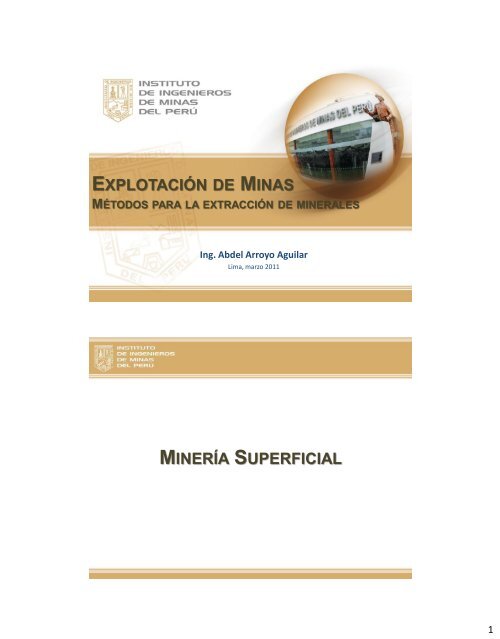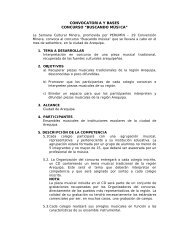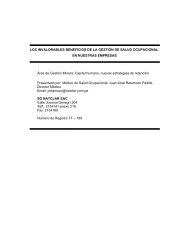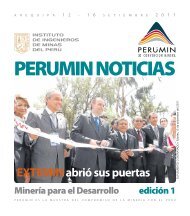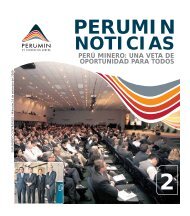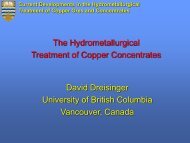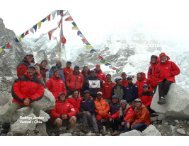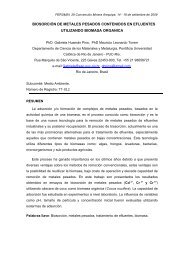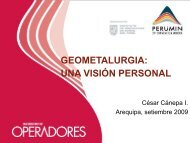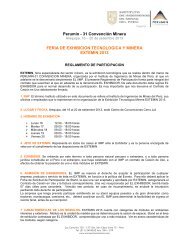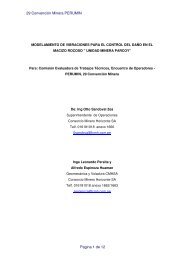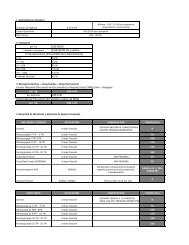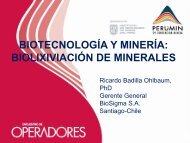IIMP Explotación de minas - PERUMIN - 31 Convención Minera
IIMP Explotación de minas - PERUMIN - 31 Convención Minera
IIMP Explotación de minas - PERUMIN - 31 Convención Minera
Create successful ePaper yourself
Turn your PDF publications into a flip-book with our unique Google optimized e-Paper software.
EXPLOTACIÓN DE MINAS<br />
MÉTODOS PARA LA EXTRACCIÓN DE MINERALES<br />
Ing. Ab<strong>de</strong>l Arroyo Aguilar<br />
Lima, marzo 2011<br />
MINERÍA SUPERFICIAL<br />
1
oduct line<br />
TORO 007<br />
Capacity 10 000 kg<br />
TORO 400<br />
TORO 400 Electric<br />
6<br />
6 700 kg<br />
(22 000 lb)<br />
14 800 lb)<br />
Capacity 9 600 kg<br />
(21 200 lb)<br />
TORO 2500 Electric<br />
Capacity 25 000 kg<br />
TORO 0011<br />
Capacity 21 000 kg<br />
(55 100 lb)<br />
(46 300 lb)<br />
100 kg<br />
500 lb)<br />
TORO 50 plus<br />
Capacity 50 000 kg<br />
Supra 0012H<br />
Capacity 80 000 kg<br />
(110 200 lb)<br />
(176 400 lb)<br />
MINERÍA SUPERFICIAL<br />
MÉTODOS DE EXPLOTACIÓN<br />
G Explotación Pirquén v/s Racional<br />
G Centena <strong>de</strong> métodos <strong>de</strong> explotación<br />
G Explotación <strong>de</strong> Superficie<br />
G Explotación Subterránea<br />
G Minería Superficie v/s Subterránea<br />
SELECCIÓN MÉTODO DE EXPLOTACIÓN<br />
Tamaño, forma y profundidad <strong>de</strong>l <strong>de</strong>pósito<br />
Aspectos fisiográficos: topografía, clima, etc.<br />
Entorno geológico y geoestructural <strong>de</strong>l sector<br />
Propieda<strong>de</strong>s fisicomecánicas <strong>de</strong> la mena y roca <strong>de</strong> caja<br />
Condiciones <strong>de</strong> aguas subterráneas e hidráulicas zona<br />
Factores económicos: - Precio<br />
- Ley <strong>de</strong> la mena<br />
- Costos <strong>de</strong> explotación<br />
- Tasa <strong>de</strong> producción<br />
- Capital existente, etc.<br />
Factores ambientales: - Preservación flora y fauna<br />
- Aire y fuentes <strong>de</strong> agua<br />
2
CONDICIONES DE<br />
TRABAJO<br />
DILUCION, SELECTIVIDAD<br />
Y RECUPERACION<br />
ENERGIA DEMANDADA<br />
MECANIZACION<br />
Minería Superficie v/s Minería<br />
Subterránea<br />
PRODUCTIVIDAD<br />
COSTOS DE OPERACIÓN<br />
NIVEL DE INVERSIONES<br />
MINERIA DE SUPERFICIE<br />
3
TIPOS DE EXPLOTACION<br />
• Explotación a Tajo Abierto (Open Pit)<br />
• Explotación por Canteras (Quarry Mining)<br />
• Explotación Aluvial (Alluvial Mining)<br />
• Explotación por Destape (Strip Mining)<br />
• Explotación por Recolección (Harvesting Mining)<br />
RECOLECCIÓN<br />
4
Explotación por Destape<br />
7
Explotación Aluvial<br />
9
CANTERAS<br />
12
TAJO ABIERTO<br />
14
MODELO DE BLOQUES<br />
.<br />
. . . .<br />
. .<br />
. .<br />
. . . .<br />
. . .<br />
. .<br />
. .<br />
15
UBC<br />
a x b x h<br />
MODELO TRIDIMENSIONAL<br />
DE BLOQUES<br />
D<br />
A<br />
B<br />
C<br />
Sulfuro Alta Ley<br />
Sulfuro Baja Ley<br />
<strong>Minera</strong>lizado<br />
Óxidos<br />
Estéril<br />
16
Partes <strong>de</strong> un Banco<br />
Cresta<br />
Pata<br />
q<br />
bb<br />
1010<br />
1000<br />
b<br />
h<br />
h = altura banco<br />
bb = berma banco<br />
b = talud banco<br />
q = Back break<br />
18
Ángulos <strong>de</strong> Talud<br />
Partes <strong>de</strong> una Rampa<br />
1 Pie<br />
2 Cabeza<br />
3 Descanso<br />
4 Pendiente<br />
5 Ancho<br />
6 Camellón <strong>de</strong> seguridad<br />
3<br />
5<br />
1 4<br />
2<br />
19
SECUENCIA DE EXTRACCION<br />
PIT FINAL FASES EXPANSIONES<br />
2 1<br />
1<br />
2<br />
3 4 5<br />
20
SECUENCIA DE FASES<br />
22
48N<br />
42N<br />
49NW<br />
51W<br />
38S<br />
52W<br />
TAJO EN<br />
OPERACION<br />
23
B = bur<strong>de</strong>n<br />
E = espaciamiento<br />
ANCHO TRONADA<br />
B<br />
E<br />
LARGO TRONADA<br />
B = bur<strong>de</strong>n<br />
Lp = Largo <strong>de</strong> perforación<br />
h = Altura <strong>de</strong> banco<br />
cf = Carga <strong>de</strong> fondo<br />
E = Espaciamiento<br />
p = Pasadura<br />
cc = Carga <strong>de</strong> columna<br />
26
Perforadoras Rotopercusión<br />
PERFORADORAS<br />
DE SUPERFICIE<br />
27
Perforadoras Rotatorias<br />
28
Perforadoras Rotatorias y DTH<br />
Broca DTH<br />
Carguío <strong>de</strong> Explosivos<br />
29
BS<br />
DS<br />
Ac<br />
RGc<br />
DS<br />
DD<br />
Berma o<br />
Cuneta<br />
Pistas<br />
Pistas<br />
Berma o<br />
Cuneta<br />
Zanja<br />
hacia el<br />
banco<br />
hacia el<br />
rajo<br />
Distancia<br />
<strong>de</strong><br />
Seguridad<br />
32
1.5 Km<br />
Rampa <strong>de</strong> Acceso<br />
120 m<br />
Emplazamiento <strong>de</strong> Palas<br />
33
Martillo<br />
Picador<br />
Hidráulico<br />
34
MINERÍA SUBTERRÁNEA<br />
35
SELECCIÓN MÉTODO DE<br />
EXPLOTACIÓN<br />
‣ Tamaño, forma y profundidad <strong>de</strong>l <strong>de</strong>pósito<br />
‣ Aspectos fisiográficos: topografía, clima, etc.<br />
‣ Entorno geológico y geoestructural <strong>de</strong>l sector<br />
‣ Propieda<strong>de</strong>s fisicomecánicas <strong>de</strong> la mena y roca <strong>de</strong> caja<br />
‣ Condiciones <strong>de</strong> aguas subterráneas y hidraúlicas zona<br />
‣ Factores económicos: - Precio<br />
- Ley <strong>de</strong> la mena<br />
- Costos <strong>de</strong> explotación<br />
- Tasa <strong>de</strong> producción<br />
- Capital existente, etc.<br />
‣ Factores ambientales: - Preservación flora y fauna<br />
- Aire y fuentes <strong>de</strong> agua<br />
36
MÉTODOS<br />
EXPLOTACIÓN SUBTERRÁNEA<br />
CASERONES<br />
AUTOSOPORTADOS<br />
CASERONES<br />
SOPORTADOS<br />
CON<br />
HUNDIMIENTO<br />
• Open Stopes (Caserones Abiertos)<br />
• Rooms & Pillars (Caserones y Pilares)<br />
• Sublevel Stoping (Exp. por Subniveles)<br />
• Cut & Fill (Corte y Relleno)<br />
• Long Wall (Frentes Largos)<br />
• Square Set (Cuadros <strong>de</strong> Ma<strong>de</strong>ra)<br />
• Sublevel Caving (Hundimiento por Subniveles)<br />
• Block Caving – Panel Caving<br />
(Hundimiento Progresivo <strong>de</strong> Bloques)<br />
• Explotación selectiva en cuerpos reducidos<br />
• Explotación másiva y a gran escala<br />
37
Costos<br />
Métodos Subterráneos<br />
Método<br />
Explotación<br />
Block Caving<br />
Room and Pillars<br />
Sublevel Stoping<br />
Sublevel Caving<br />
Long Wall<br />
Shrinkage Stoping<br />
Cut and Fill<br />
Costo<br />
Relativo<br />
1,0<br />
1,2<br />
1,3<br />
1,5<br />
1,7<br />
5,0<br />
6,0<br />
Rango<br />
Costos<br />
4 – 12 US$/t<br />
10 – 20 US$/t<br />
10 – 25 US$/t<br />
15 – 25 US$/t<br />
20 – 30 US$/t<br />
30 – 60 US$/t<br />
35 – 70 US$/t<br />
38
OPEN STOPES<br />
39
Análisis <strong>de</strong>l Método<br />
1. DESARROLLO & PREPARACION<br />
– Acceso al <strong>de</strong>pósito<br />
– Desarrollo lateral<br />
Niveles principales (30 – 60 m)<br />
Chimenea laterales UE<br />
– Preparación<br />
Chimenea central<br />
Puente natural <strong>de</strong> mena<br />
Chimeneas cortas<br />
Embudos<br />
Buzones<br />
40
Análisis <strong>de</strong>l Método<br />
2. EXPLOTACION<br />
– Bancos Derechos<br />
– Bancos Invertidos<br />
3. CARACTERÍSTICAS MÉTODO<br />
– Baja inversión inicial<br />
– Preparación reducida<br />
– Poca mecanización M. O. abundante<br />
– Ventilación prácticamente natural<br />
– Baja productividad: 2 – 10 t/h-turno<br />
– Soporte nulo o mínimo Buena seguridad<br />
– Costo <strong>de</strong> explotación alto<br />
– Requiere <strong>de</strong> leyes altas<br />
– Poco selectivo<br />
43
LONGWALL MINING<br />
• Método soportado para yacimientos tipo manto.<br />
• Explotación: Avance <strong>de</strong> un frente largo con perforación/ tronadura<br />
o con cortadores mecánicos (“cepillos”).<br />
• Sector explotado es <strong>de</strong>jado abierto o se controla su hundimiento.<br />
Longwall Mining en roca dura:<br />
<strong>minas</strong> <strong>de</strong> oro, cromo y platino en Sudáfrica.<br />
45
Equipos Empleados<br />
Axera XLP<br />
Robolt XLP<br />
EJC 88 XLP loa<strong>de</strong>r<br />
ROOMS & PILLARS<br />
46
Campo <strong>de</strong> Aplicación<br />
• Mantos Buzamiento bajo a mo<strong>de</strong>rado ( ≤ 40º )<br />
• Potencias frecuentes: 2 a 20 m<br />
• Casos excepcionales: 40 a 60 m<br />
Problemas <strong>de</strong> seguridad (estabilidad techo)<br />
Baja recuperación<br />
• Gran <strong>de</strong>sarrollo lateral en plano horizontal<br />
• No aconsejable en yacimientos muy profundos (H > 200 m)<br />
Exceso <strong>de</strong> sobrecargas<br />
Pilares <strong>de</strong> gran tamaño<br />
Alta <strong>de</strong>nsidad <strong>de</strong> pilares<br />
• Existencia <strong>de</strong> agua Inestabilidad <strong>de</strong> rocas<br />
• Explotación: Mena extraída CASERONES<br />
Mena in situ PILARES<br />
47
SUB LEVEL STOPING<br />
EXPLOTACION POR SUBNIVELES<br />
• Explotación en realce<br />
• Preparación <strong>de</strong> la base Nivel <strong>de</strong> transporte (NT)<br />
• Ejecución <strong>de</strong> subniveles <strong>de</strong> perforación (SP)<br />
• Confección <strong>de</strong> cara libre<br />
• Arranque en franjas verticales mediante tiros largos <strong>de</strong>s<strong>de</strong> SP<br />
• Mena cae a fondo <strong>de</strong>l caserón Extracción en NT<br />
• Retiro <strong>de</strong>l mineral tronado con equipos mecanizados<br />
• Yacimientos <strong>de</strong> gran tamaño Caserones quedan separados por pilares<br />
y puentes mineralizados o son rellenados<br />
50
CAMPO DE APLICACION<br />
- Cuerpos <strong>de</strong> gran buzamiento Mayor < reposo material<br />
Gravedad<br />
- Vetas <strong>de</strong> potencia ≥ 2 m y masas mineralizadas<br />
- Roca <strong>de</strong> cajas relativamente estables<br />
- <strong>Minera</strong>l competente<br />
- Límites cuerpo mineralizado + ó - regulares<br />
2 – 30 m<br />
51
SHRINKAGE STOPING<br />
• Explotación por realce con almacenamiento <strong>de</strong> mineral en el<br />
caserón Cámara almacén<br />
• Vetas <strong>de</strong> poca potencia (< 2m) y manteo pronunciado (> 60º)<br />
• Arranque por franjas horizontales en forma ascen<strong>de</strong>nte<br />
• Se extrae ~ 40 % <strong>de</strong>l material tronado y el resto queda en el<br />
caserón plataforma <strong>de</strong> trabajo<br />
• <strong>Minera</strong>l almacenado se extrae al finalizar explotación caserón queda vacío<br />
• <strong>Minera</strong>l no <strong>de</strong>be ser <strong>de</strong>gradable ni alterable fácilmente<br />
• No permite alta mecanización al interior <strong>de</strong>l caserón<br />
60
CUT & FILL<br />
61
CORTE Y RELLENO<br />
• Explotación por realce generalmente<br />
• Arranque <strong>de</strong>l mineral por franjas horizontales<br />
• <strong>Minera</strong>l tronado se evacua totalmente <strong>de</strong>l caserón<br />
• Caserón va siendo rellenado con material estéril plataforma <strong>de</strong><br />
trabajo y sostenimiento <strong>de</strong> pare<strong>de</strong>s<br />
• Método <strong>de</strong> alto costo aplicable a minerales <strong>de</strong> alta ley<br />
• Pue<strong>de</strong> ser altamente mecanizado tanto al interior como en la<br />
mecanizado, base <strong>de</strong>l caserón<br />
• Método muy flexible y <strong>de</strong> elevada selectividad<br />
62
SUBLEVEL CAVING<br />
64
HUNDIMIENTO POR SUBNIVELES<br />
• Explotación por rebaje mediante subniveles<br />
• Subniveles forman una red <strong>de</strong> galerías que cubre toda la superficie <strong>de</strong>l yacimiento<br />
• Mena y roca estéril <strong>de</strong> pobre competencia<br />
• Cada galería perforación <strong>de</strong> tiros en abanicos, hundimiento <strong>de</strong>l mineral, carguío y<br />
transporte <strong>de</strong>l mineral a O.P.<br />
• Material estéril hun<strong>de</strong> continuamente sobre el mineral arrancado<br />
• Generación <strong>de</strong> cráter <strong>de</strong> subsi<strong>de</strong>ncia en superficie<br />
• En cada subnivel se perfora, carga y transporta mineral<br />
• Dilución y pérdidas <strong>de</strong> mineral significativas<br />
• Alre<strong>de</strong>dor <strong>de</strong> 20 % <strong>de</strong>l mineral se extrae en los <strong>de</strong>sarrollos<br />
65
Equipos Empleados<br />
66
BLOCK CAVING<br />
PANEL CAVING<br />
HUNDIMIENTO PROGRESIVO DE<br />
BLOQUES<br />
• Yacimientos muy gran<strong>de</strong>s y masivos<br />
• Buzamiento >> que ∠ reposo material<br />
• Gran extensión vertical<br />
• Estabilidad <strong>de</strong> mena pobre: socavación inferior hundimiento y<br />
fragmentación <strong>de</strong> roca<br />
• Perforación y tronadura mínima socavación inferior<br />
• Mena se fractura y quiebra a si mismo por esfuerzos internos y gravedad<br />
• <strong>Minera</strong>l <strong>de</strong> ley relativamente baja o bajo valor comercial: diseminados <strong>de</strong> cobre y<br />
fierro.<br />
• Superficie permite la subsi<strong>de</strong>ncia cráter<br />
• Producción <strong>de</strong> gran<strong>de</strong>s tonelajes<br />
67
BLOCK CAVING<br />
PANEL CAVING<br />
68
EQUIPOS EMPLEADOS<br />
74


